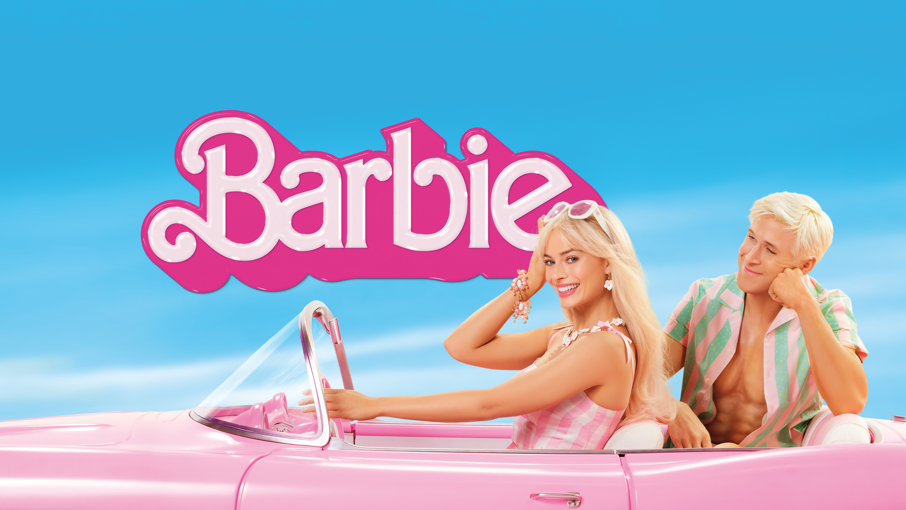
Barbie is — and has always been — a material girl.
That’s one message from scholars as the first live-action “Barbie” film opens Friday amid a fresh wave of merch, product collabs and advertising that highlights her characteristic consumerism.
That consumption also isn’t all Barbie represents, they say, pointing to controversies over her problematic proportions, her potential to empower as a single woman without children and her evolution to reflect American culture’s changing tastes.
Barbie’s Corvette convertible, tricked-out Dreamhouse and revolving door of pink outfits in the film say as much about the titular character as any dialogue in a movie that features three recent Oscar nominees — director Greta Gerwig and stars Margot Robbie (Barbie) and Ryan Gosling (Ken). One tween in the film reportedly even blasts Barbie for promoting “shallow consumerism.”
Off screen, Barbie’s relationship with consumption has not been the primary focus of criticism toward her, but it deserves attention, scholars say. That it has not elicited nearly as much outcry as the doll’s appearance, they argue, reflects how normalized capitalism and consumerism are in American culture.
Having first appeared on the market in 1959, the doll’s association with consumerism is not a coincidence but a reflection of the social context in which Mattel debuted her, said Lenore Wright, author of “Athena to Barbie: Bodies, Archetypes, and Women’s Search for Self.”
“She comes right at the center of American mass consumerism and the postwar development of things like Levittowns — designed home developments — and suburbia and women moving away from the workforce and back into the home after the war,” said Wright, professor of interdisciplinary studies and philosophy at Baylor University.
During this time, Wright said, marketers targeted women in a way that suggested they were exercising agency by, say, picking the color of a refrigerator door handle. They appealed to women by advertising that major appliances had been “femineered,” or made with women in mind.
“The key story that gets told by Barbie is a story about how the American dream is an American dream of consumption,” said Dustin Kidd, an associate professor of sociology at Temple University and director of its general education program. “Barbie has especially done that through the concept of the teenage girl’s bedroom — from the toys that she might have in her bedroom to the ways that she might decorate her bedroom, then to the ways in which her bedroom kind of gets extended out into her car and other spaces that are part of her world, the mall and so forth.”
Kidd said that the story of the teenager was not always centered on money, excess and style. But over the past few decades that has become the dominant narrative, and “Barbie is a major part of that cultural shift.”
Barbie launched during a period known as the golden age of advertising, and she was marketed in a way that prompted consumers to keep spending money. Shoppers not only bought the dolls but various outfits to clothe her in as well.
“Then you could purchase other things to kind of grow the Barbie universe and that evolved over time,” Kidd said. “The house, the car, all those things got added to that Barbie universe to build up your Barbie doll’s world, including additional people for her to live with. So all of her friends, including all the Kens, and so many different careers for Barbie to work within, created all of these opportunities for expanding the marketing of Barbie as the story of a toy.”
Materialism and consumerism figure heavily into the promotion of the “Barbie” film. Ahead of its premiere, Mattel collaborated with a wide range of companies on merchandise to promote the movie, including Hot Topic, Forever 21, Xbox, Ulta Beauty, Bloomingdale’s and Hot Wheels. Fans can also use Airbnb to stay at a real-life version of Barbie’s Malibu DreamHouse or experience the doll’s lifestyle and careers through the interactive activities offered through the World of Barbie in Los Angeles.
“In some sense Barbie invites more of a critique because she is a role model of mass consumption, but she isn’t given that critique,” Wright said. “She is like other female archetypes, really criticized for what she represents and how she’s presenting herself in the world. It really comes back to women’s embodiment and what that symbolizes.”
Instead of being called out for encouraging mass consumption, Barbie has been pilloried for representing a narrow — and some have said “anatomically impossible” — standard of beauty. An early version of the doll came with a book on how to lose weight with two words of advice: “Don’t eat!” A scale revealing that she weighed 110 pounds accompanied that Barbie. Over the years, the doll has been blamed for promoting disordered eating in young girls.
“We worry about young girls who may develop body image dysmorphia or eating disorders or other things as a result of being exposed to not just Barbie but any image of woman in this way,” Wright said. But she suggested that to strictly view Barbie as the embodiment of women’s oppression and objectification ignores the doll’s subversiveness.
Barbie inventor Ruth Handler thought the fact that Barbie was career-oriented with no husband or children made her a progressive figure, Wright said.
“She has 200 occupational choices, and she’s out there making her own money,” Wright said. “I mean, my gosh, talk about freedom from oppression, so it’s so interesting that we get obsessed with how she’s embodied and [how it] represents objectification and oppression. Really, as a toy, and as kids play with her, that’s not what they focus on. That’s not how she’s used to engage their imagination.”
During the third wave feminism movement of the 1990s, however, backlash against Barbie infiltrated popular culture. The music video for Soundgarden’s 1994 hit “Black Hole Sun” shows Barbie roasting, and then melting, over a grill. That same year, a “Simpsons” episode — “Lisa vs. Malibu Stacy” — included a storyline about a doll based on Malibu Barbie. The doll wishes shopping was a school subject, wears makeup so boys will like her and believes that thinking too much causes wrinkles. The episode ignored the challenging career roles, including astronaut, that Barbie has occupied since shortly after her 1959 start. Rather, it indicated, through the words of Lisa Simpson, that the doll served to turn girls into “vacuous ninnies.”
“The initial backlash against Barbie came from a kind of scholarly media criticism that was taking place in the ’90s that focused on the gap between what we would see in the media and what we knew about reality,” Kidd said. “And that led to lots of critiques of different types of popular culture — from sitcoms like ‘Friends,’ where the apartment was way bigger than what anyone like that could afford in New York City to critiques of Barbie’s measurements.”
That moment in feminist history has since drawn its own criticism for focusing on children’s toys instead of larger structural inequalities, Kidd said,
“We’ve also recognized that the way that our media is constructed isn’t the be-all, end-all of what it means to an audience member,” he added. “So, it’s not up to a professor to say, ‘Barbie’s measurements are this, so that means she’s unrealistic, or she’s a bad role model.’ That’s really up to the kids playing with Barbie and their parents to decide what Barbie actually means to them.”
The “Barbie” film flips the feminist critiques of Barbie on their head, portraying Barbieland as a matriarchal society with empowered women and dependent men. A number of conservatives have attacked the movie, with Ginger Luckey Gaetz, the wife of Rep. Matt Gaetz, disparaging it because it “neglects to address any notion of faith or family” and because Ken is not virile enough for her liking. Others such as Sen. Ted Cruz and Sen. Marsha Blackburn have accused the “Barbie” movie of promoting Chinese propaganda because of a scene with an inaccurate map of the “nine-dash line,” a contested portion of the South China Sea. The map — the film’s studio, Warner Bros., said in a statement — portrays Barbie’s fictional journey from Barbieland to the real world.
Both Barbieland and the real world have one thing in common: they include people of all racial backgrounds. But everyone in Barbie’s orbit was White in the years after the doll’s 1959 release.
“For a long time, Barbie was bounded by race, for instance, so that’s been part of the backlash,” Kidd said.
Mattel introduced its first Black dolls in the late 1960s, but it would take until 1980 before Barbie herself was portrayed as Black. The doll was released after Black-owned companies such as the now defunct Shindana Toys, which Mattel provided financial and professional support to early on, successfully debuted a line of Black dolls in the late 1960s. These dolls stood out because they were modeled on the actual facial features of Black children and designed to instill pride in such youth.

Although Barbie dolls evolved and diversified — even in the 1990s they came in a variety of skin tones and ethnicities — the brand faced fierce competition from the newly launched Bratz dolls after the turn of the millennium. Bratz dolls were not only racially diverse but looked trendier and more provocative than Barbie. MGA Entertainment, the maker of Bratz, and Mattel spent years engaged in legal battles over trade secrets, rightful ownership of the Bratz dolls and more. Ultimately, Mattel was ordered to pay MGA a settlement of more than $300 million. In 2010, Mattel launched its Monster High line of dolls which offered an edgy alternative to Barbie and served as direct competitors to Bratz dolls.
The 2018 documentary film “Tiny Shoulders: Rethinking Barbie” shows that Barbie’s declining popularity in the 21st century was cause for concern as sales of the dolls slowed. Still, the brand has worked to stay relevant generations after it debuted during the same decade that color TV premiered. Today, Barbie comes with different body types, hairstyles and hair textures, and physical abilities. She is available as historical figures including Susan B. Anthony, Ida B. Wells, Madam CJ Walker, Helen Keller, Eleanor Roosevelt, Anna May Wong and Rosa Parks.
Barbie isn’t just one archetypal woman, Wright said, but represents multiple archetypes. In that way, she’s subversive. On the surface, Barbie looks happy, feminine and nonthreatening, Wright contends, but she’s deeper than her appearance suggests.
In short, this Barbie is complicated.
“She has that beauty of Venus,” Wright said. “She’s got that power of Athena. She’s out there in the workforce, as it were, through kind of projected occupations, and then, like Mary, she’s virginal. So, she brings together dimensions of at least those three archetypes in really clever and coy ways, and I think embodies where we are culturally.”
Originally published by The 19th
